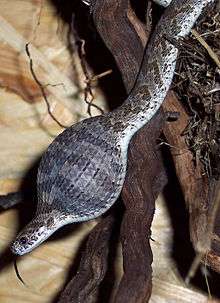Dasypeltis scabra
| Dasypeltis scabra | |
|---|---|
 | |
| D. scabra after swallowing an egg | |
| Scientific classification | |
| Kingdom: | Animalia |
| Phylum: | Chordata |
| Subphylum: | Vertebrata |
| Class: | Reptilia |
| Order: | Squamata |
| Suborder: | Serpentes |
| Family: | Colubridae |
| Subfamily: | Colubrinae |
| Genus: | Dasypeltis |
| Species: | D. scabra |
| Binomial name | |
| Dasypeltis scabra (Linnaeus, 1758) | |
| Synonyms | |
| |
Dasypeltis scabra, known as the common egg eater, egg-eating snake or rhombic egg eater,[1] is a species of nonvenomous snake endemic to Africa.
Geographic range
Dasypeltis scabra is found in sub-Saharan Africa. It can also be found in Saudi Arabia and in other countries of the Middle East.
Description
It grows to a length of 20–35 inches (51–89 cm), and has almost toothless jaws. Dorsally, it has a series of rhomboidal dark brown spots on a lighter background. There is an alternating series of brown spots on each side. Ventrally it is yellowish, either uniform or with dark dots.[2]
Mimicry
It has been suggested that nonvenomous Dasypeltis scabra is a mimic of venomous Echis carinatus, the saw-scaled viper, which it strongly resembles.[3]
D. scabra also closely resembles Causus rhombeatus, the rhombic night adder. These two species may be distinguished by the shape of the pupil of the eye. Snakes of the genus Dasypeltis have vertical pupils, whereas snakes of the genus Causus have round pupils.[4] However, it is possible in darker areas for the vertical eyes to become round, so this is not a true verify.
Habitat
Dasypeltis scabra can be found in a variety of habitats. They are not found in closed-canopy forests nor in true deserts, but do inhabit most ecosystems between these extremes.[5]
Behavior
The rhombic egg eater is nocturnal. Although mainly terrestrial, it is a good climber and is known to scale rock outcroppings and climb trees to raid birds' nests.[5]
Diet
Dasypeltis scabra feeds exclusively on eggs. The lining of the mouth has small, parallel ridges, very similar to human fingerprints, which aid in grasping the shell of an egg. Once swallowed, the egg is punctured by specialized vertebral hypapophyses which extend into the esophagus. The shell is then regurgitated in one piece, and its contents passed along to the stomach.[6]
Defense
When disturbed, the snake inflates itself, "hisses" by rapidly rubbing together the rough, keeled scales on the side of its body, and strikes with its mouth kept wide open.[7]
Reproduction
This species is oviparous. In summer, a sexually mature female may lay one or two clutch of 6-25 eggs each. The eggs measure 36 mm × 18 mm (1.42 in × 0.71 in). Hatchlings are 21–24 cm (8.5–9.5 in) in total length.[5]
Subspecies
Two subspecies are recognized, including the nominotypical subspecies.[8]
The subspecific name, loveridgei, is in honor of British herpetologist Arthur Loveridge.
References
- ↑ Geniez, P.; P.-A. Crochet; B. Maryan & D. Broadley (2009). "Dasypeltis scabra". IUCN Red List of Threatened Species. Version 3.1 (3.1). International Union for Conservation of Nature. Retrieved November 9, 2010.
- ↑ Boulenger, G.A. 1894. Catalogue of the Snakes in the British Museum (Natural History). Volume II., Containing the Conclusion of the Colubridæ Aglyphæ. London: Trustees of the British Museum (Natural History). (Taylor and Francis, printers). xi + 382 pp. + Plates I.- XX. (Dasypeltis scabra, pp. 354-357).
- ↑ Sternfeld, R. 1910. "Zur Schlangenfauna Deutsch-Südwestafrikas. Mehrere Fälle von Mimikry bei afrikanischen Schlangen". Mit. zool. Mus. Berlin 5: 51-60.
- ↑ Causus rhombeatus at Life Desks, Snake Species of the World. http://snake species of the world.lifedesks.org/pages/360.
- 1 2 3 Branch, Bill. 2004. Field Guide to Snakes and Other Reptiles of Southern Africa. Third Revised edition, Second impression. Sanibel Island, Florida: Ralph Curtis Books. 399 pp. ISBN 0-88359-042-5. (Dasypeltis scabra, pp. 95-96 + Plate 15).
- ↑ Mattison, Chris. 2006. Snake. New York: DK Publishing. 192 pp.
- ↑ Gans, Carl, and Neil D. Richmond. 1957. "Warning Behavior in Snakes of the Genus Dasypeltis". Copeia 1957 (4): 269-274.
- ↑ The Reptile Database. www.reptile-database.org.
Further reading
- Linnaeus, C. 1758. Systema naturae per regna tria naturae, secundum classes, ordines, genera, species, cum characteribus, diferentiis, synonymis, locis. Tomus I. Editio Decima, Reformata. Stockholm: L. Salvius. 824 pp. (Coluber scaber, p. 223).
- Mertens, R. 1954. "Neue Schlangenrassen aus Südwest- und Südafrika". Zoologischer Anzeiger 152: 213-219. (Dasypeltis scabra loveridgei ).
- Morris, P.A. 1948. Boy's Book of Snakes: How to Recognize and Understand Them. A volume of the Humanizing Science Series, edited by Jaques Cattell. New York: Ronald Press. viii + 185 pp. (Dasypeltis scaber, pp. 143, 181).
